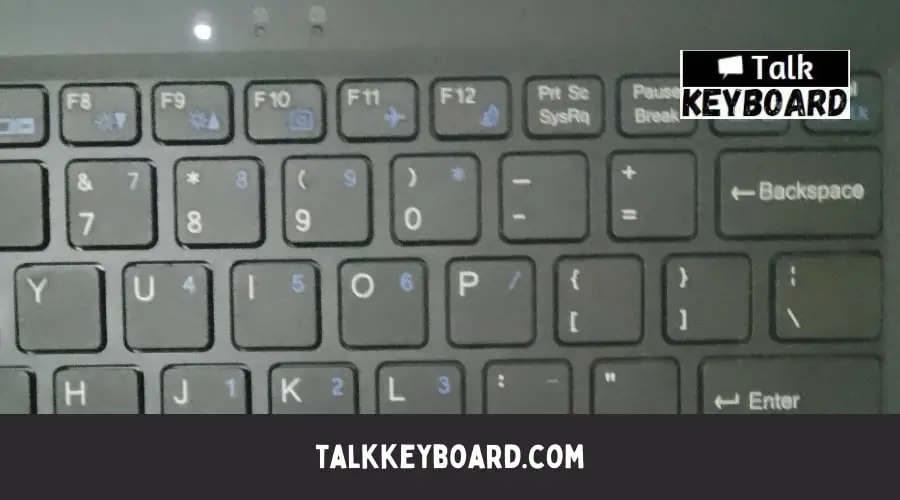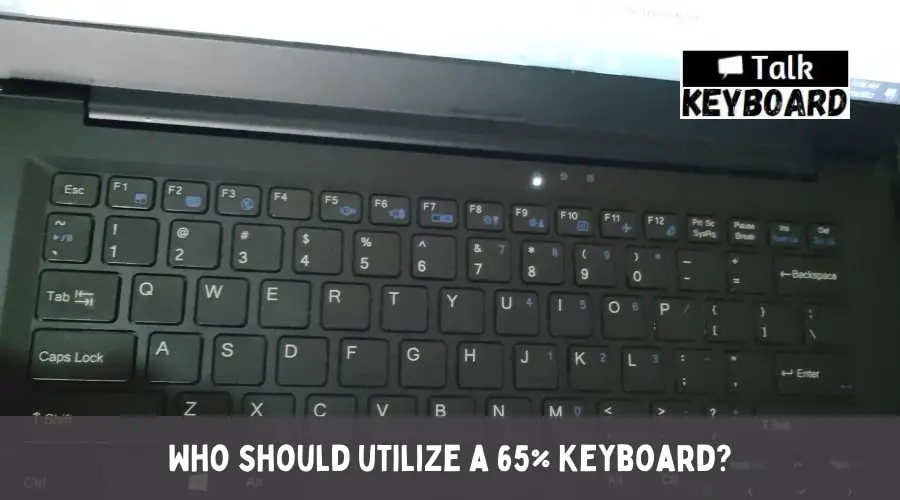The number buttons on the right edge of the keyboard may be less important if you’re a coder or a gamer. The Numpad may be more difficult to get rid of for those who work in finance or accounting. These keyboards, which take up minimal desk space, are ideal alternatives if you are searching for a smaller keyboard.
There is no doubt that 65 % keyboards are gaining popularity among those who like typing on mechanical keyboards. With their small size and usefulness, they are an excellent complement to any workplace arrangement. A complete guide to 65% keyboards is provided here to assist you.
65% Keyboard
In comparison to a full-size or tenkeyless keyboard, the 65 % arrangement includes just 65 % of the buttons of a qwerty keyboard with a numeric pad. Designated arrow buttons and an additional row of keys on the right edge of the keyboard are found on around 65 % of keyboards. Buttons including page up, page down, home, or delete, which would ordinarily be located over the arrow buttons, are frequently added to the additional row.
The number of buttons on a 65 percent keyboard will normally need 67 to 68 switches. Yet, a separated spacebar is an option on certain keyboards. In order to utilize a separated spacebar arrangement, you’ll require to add 1-2 more switches to your panel, totaling to 70. For those who will not be using a split spacebar, it is preferable to get 70 switches for their 65 percent keyboard, although you don’t require any more switches.
Key Features
If you adore the look and feel of 60 percent keyboards but can’t function without arrow buttons, it is the keyboard you’re looking for. 65 percent keyboards are almost identical to the 60 percent form factor in terms of functionality. The return of the arrow buttons, on the other hand, solves the primary problem with 60 percent of keyboards: the lack of arrow buttons. In addition, you have four home group keys, which may normally be binded to any other key you choose if you so want.
Because of the way it balances size and usefulness, this arrangement has developed to be one of the most preferred keyboard layouts. Popular gaming businesses, such as Razer, have taken note and are now developing their own 65 percent gaming keyboards to compete with the competition.
It is somewhat lengthier than keyboards with 60 percent of the keys. When compared to other keyboards, such as the TKL and 75 percent keyboards, it is still a tiny keyboard.
In order to mitigate your lost keys, you will require to use several layers once again. Nonetheless, the knowledge curve will not be as steep as it would be with 60 percent keyboards, since 65 percent of keyboards provide almost the entire capability straight out of the box.
The sole disadvantage of 65 percent keyboards is that they are designed in an exclusive manner. 65 percent of keyboards are not standardized in the same way that 75 percent keyboards are not standardized.
This implies that you will not be able to simply change out the components of your keyboards and replace them with aftermarket components. In addition, you will need to ensure that your keycap set has a shorter right shift (1.75U) in order for it to be compatible with your board.
Missing Buttons on 65% Keyboard
In order to get the Numpad and the F1-12 buttons on a 65 percent keyboard, you’ll need to glance at either the 75 or 86% ten key-less or full-size keyboards.
When it comes to other absent buttons, it depends on the specific brand. Some keyboards feature all of the following buttons whereas others just have a few, such as insert, delete, page up, page down, and print screen. Page up and page down keys are often present, however, the addition of other buttons differs from manufacturer to manufacturer.

However, if your keyboard does not include a print screen key, you can typically program one of the keys you don’t use very frequently to do what you want it to do instead.
More than two-thirds of keyboards lack specific media buttons. Nevertheless, a function layer on many 65 percent of keyboards has these media functions. Accessing this feature may need different keys on different keyboards. You may also use customizable shortcut keys or reconfigure keys to manage media playback.
60% vs. 65% Keyboards
The inclusion of specialized arrow buttons is one of the most significant distinctions between a 60% and a 65% keyboard. People that deal with a lot of data or spreadsheets may find these quite helpful.
The second big change is the presence of a few more function buttons on the right-hand edge of the keyboard, generally about four of them. With them, you don’t have to save them in a level or develop customized hotkeys to perform extra keyboard functions.
Who should utilize a 65% Keyboard?

A 65 percent keyboard is ideal for folks who like the minimalist design of a 60 percent keyboard but still want specific arrow buttons. With just one extra row of buttons, it’s yet a very tiny and tidy structure that fits effectively on basic desk settings or for individuals who are limited on workspace without sacrificing performance. They’re also rather mobile, so if you require to commute with your mechanical keyboard frequently, this configuration is a nice option.
The small keyboard arrangement of 65 percent implies you have extra room for your mouse. If you often use your mouse, this may make a significant impact in your portability by enabling you to utilize more of your arms for larger motions, reducing pressure on your wrists and strain on the carpal tunnel, elbows, and shoulders.
Because a 65 percent layout excludes the function row and Numpad, 65 percent keyboards aren’t a viable alternative for users who need these buttons. There is still the alternative of purchasing a separate Numpad, but for many, this contradicts the point of purchasing a tiny keyboard, to begin with.
A decent keyboard is undoubtedly the most crucial tangible weapon in a writer’s inventory since the bulk of your workday as a writer has consumed typing and browsing text-based works, making 65 percent keyboards ideal for writers. The designated arrow keys on a 65 percent keyboard allow you to swiftly and simply move across lines of text in a manuscript or switch pages without having to reach them via a function level.
Finest 65% Keyboards
There are a variety of 65 percent keyboards available, but just a few stand out as superior to the others.
Drop Alt
One of the most popular 65 percent keyboards on the marketplace is the Drop Alt, according to critics. Its simple design immediately elevates it to the position of prominence on a minimalistic workstation. No other floating key style comes close to the Alt in terms of simplicity. For this reason, it is our choice for the finest floating key 65 percent keyboard.
The Drop Alt’s simple, floating key appearance is a major selling point. The top of the casing serves as a surface in Drop’s floating key architecture, allowing the keys to float. It’s crucial to bear in mind that this might lead to a more difficult bottom out.
Keychron K6
Keychron K6 is the finest 65 percent keyboard for Mac and iOS clients, as well as the greatest 65 percent keyboard for traveling, as determined by the criteria outlined above. Using this keyboard with your Mac or iPhone or iPad is a breeze, thanks to the keyboard’s built-in compatibility for Apple products, extra keycaps for Apple customers, and excellent Bluetooth communication. Although it has a considerable amount of weight, it isn’t so hefty that it would be difficult to carry when commuting.
Keychron is known for its high-quality, budget-friendly boards, and the K6 is no exception. There’s a K6 arrangement for everybody thanks to a staggering number of options.
Durgod Hades 68
The Durgod Hades 68 is our top selection for 65% of gamers, however, any of the other keyboards on the listing may be utilized. In terms of size and design, the Hades 68 is an excellent gaming keyboard. The RGB lighting shines through the PBT backlit keys, and the 13 various switch choices make it simple to locate anything you prefer.
To be honest, the Durgod Hades 68 is an excellent 65 percent gaming keyboard—and an excellent 65 percent keyboard overall. There is a plethora of switch configurations, PBT keycaps, and an aluminum keyboard enclosure to choose from. The only significant drawbacks of this panel are the absence of hot-swappable PCBs and the absence of Bluetooth, neither of which are deal breakers.
Conclusion
While preserving all of the functionality of a full-sized keyboard, mechanical keyboards that are smaller in size bring a whole new level of elegance and portability. In order to render the keyboard more manageable, 65 percent of keyboards eliminate buttons that are seldom used. A complete guide to 65 % keyboards will assist you to determine whether to acquire a lightweight and tiny keyboard for specialized applications or the regular full-sized keyboard.

I am a regular user of computer keyboards. For using keyboard face different kinds of problems and also solve it very easily. I love sharing knowledge about keyboards.
